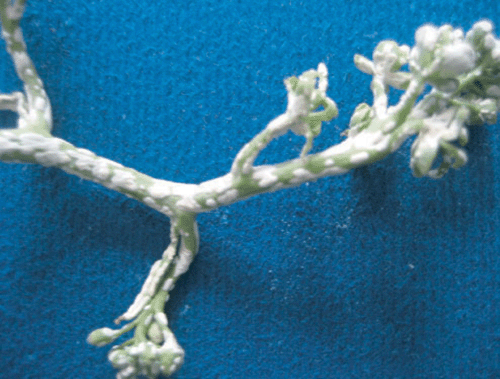Hirschfeldia incana, a new host report for white blister caused by Albugo candida in Turkey
H. Kavak A C , Z. Katircioglu B and B. Bukun AA Plant Protection Department, Agricultural Faculty, Harran University, 63040 Şanlıurfa, Turkey.
B Plant Protection Department, Agricultural Faculty, Ankara University, 06110 Dışkapı, Ankara, Turkey.
C Corresponding author. Email: hkavak@harran.edu.tr
Australasian Plant Disease Notes 2(1) 149-149 https://doi.org/10.1071/DN07058
Submitted: 26 June 2007 Accepted: 31 October 2007 Published: 15 November 2007
Abstract
Severe symptoms of white blister caused by Albugo candida were detected on Hirschfeldia incana during surveys in late spring in the Şanlıurfa district of the south-eastern Anatolia region in Turkey. This is a new host report for A. candida in this country.
Hirschfeldia incana is a common plant of waste ground in Turkey and is widespread in different continents of the world. Its leaves and seeds are edible and it is also cultivated for bees to increase honey production. During surveys in late spring of 2007 in the Şanlıurfa district of the south-eastern Anatolia region in Turkey, typical and severe symptoms of white blister disease were observed on plants of H. incana. Infection was generally localised on some branches of plants. Infected branches and buds were hyperplasic, being ~3–4 times thicker than healthy ones. The pustules were white. Sori were common on branches, mostly coalescent (Fig. 1), individual sori rarely being found, and measuring 0.5–1.2 × 1–4 mm in diameter. Sori were mostly circular, ellipsoidal or irregular shapes and formed blisters up to 3 mm in height. Approximately 80–90% of the infected branches were covered with these sori. Sporangia were more or less spherical and hyaline, uncommonly punctuate on the surface and measured 13–24 µm in diameter. Sporangiophores were hyaline and 16–25 × 27–48 µm with many being narrow at the base and broadening to the apex. Based on macroscopic and microscopic characters, and the host being in the Brassicaceae, the pathogen on H. incana was identified as Albugo candida (Glawe et al. 2004). Albugo candida has been reported on other species in the Brassicaceae in recent years (Koike 1996; Jacobson et al. 1998; Zapata et al. 2005). To our knowledge, this is the first report of a white blister disease caused by A. candida on this host in Turkey. A specimen has been lodged in the Herbarium of the Agricultural Faculty of Harran University.

|
Glawe DA,
Glass JR, Putnam ML
(2004) First report of white rust of Lunaria annua caused by Albugo candida in North America. Plant Health Progress ,
| Crossref | GoogleScholarGoogle Scholar |

Jacobson DJ,
LeFebvre SM,
Ojerio RS,
Berwald N, Heikkinen E
(1998) Persistent, systemic, asymptomatic infections of Albugo candida, an oomycete parasite, detected in three wild crucifer species. Canadian Journal of Botany 76, 739–750.
| Crossref | GoogleScholarGoogle Scholar |

Koike ST
(1996) Outbreak of white rust, caused by Albugo candida, on Japanese Mustard and Tah Tsai in California. Plant Disease 80, 1302.
| Crossref | GoogleScholarGoogle Scholar |

Zapata R,
Romero AM, Maseda PH
(2005) First Report of White Rust of Arugula Caused by Albugo candida in Argentina. Plant Disease 89, 207.
| Crossref | GoogleScholarGoogle Scholar |



